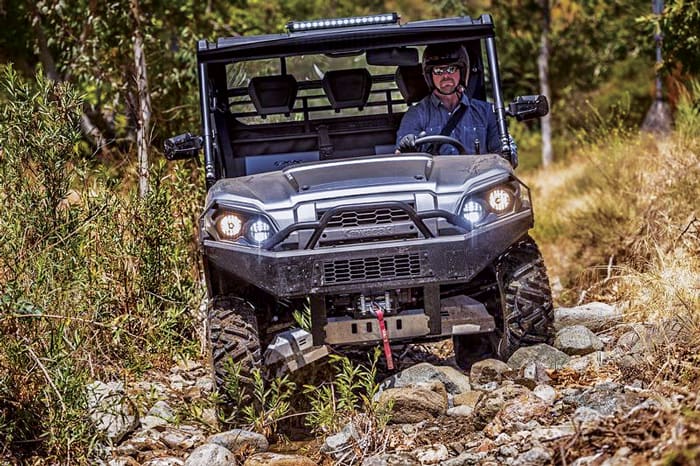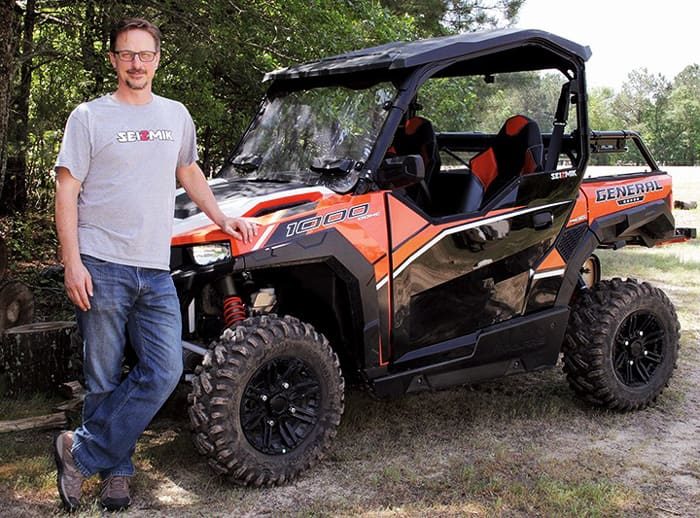
Tune in to Rural Lifestyle Dealer’s Dealer Success Academy for expanded comments from Steve Shankin, www.DealerSuccessAcademy.
Increasing UTV sales and profits hinges on showing customers a complete package — a vehicle with multiple accessory options and upgrades, something more dealers should take advantage of, according to industry expert Steve Shankin.
“Get a customer’s imagination going. Let them imagine themselves in this really cool, nice-looking UTV. Sell them something that fits with who they think they are as a person and how they want to be perceived. Get them in ‘want mode,’ not ‘need mode,’” says Shankin. He has been studying UTV customers for 18 years and is president of Seizmik, a manufacturer of UTV accessories. Shankin shares details about the size of the market, debunks excuses he hears from dealers and offers ways you can become the local expert on UTVs.
Tallying the Potential
Let’s start with some numbers regarding UTV accessories to give you an idea of what you could be earning. First, recent data from CDK Lightspeed, an analysis of 172,000 new unit invoices, shows that the average spent on UTV accessories at the time of the vehicle’s purchase is up to $1,716 from $1,098 just 2 years ago. That’s a 56% increase in dollars spent on accessories.
Dealer Takeaways
- Tap into the customer’s excitement over what a UTV can do and how ownership can make them feel.
- Display UTVs that are loaded with accessories as one way to show yourself as an expert in the segment.
- Don’t remove accessories if a customer says they don’t want them. Instead, redirect them to another model.
- Set up a scalable system for selling fully equipped UTVs. This will make it efficient for your dealership to stock and your customers to buy.
However, the data also showed that 53% of UTVs sold leave without any accessories. What’s worse is that percentage is up from 50% 2 years ago.
Another data set looks only at the dealers who are selling accessories to get a different view of the potential. “Customers of dealers who are selling vehicles with accessories on them are spending an average of $3,651 in accessories. That’s up from $2,196 two years ago. That is a whopping 66% increase.
“And the gap is getting bigger between the good and bad dealers. And the good dealers are crushing the bad dealers from a financial performance point of view, because they're understanding these dynamics about the customer, and they're selling $3,651 worth of accessories on an average utility vehicle, while the bad dealers are selling zero. And the dealers who are selling zero, those customers simply go and buy those things on the internet,” Shankin says.
Growing Market
About 465,000 UTVs were sold through all channels in 2017. Shankin says there’s a misconception that high performance models make up most of those sales. In fact, data shows that nearly half of the UTVs sold are in the utility crossover vehicle segment, while the super sport segment is only 18%. On the other end of the spectrum, pure utility vehicle sales account for about 20% of sales. (See the chart, “UTV Sales by Segment” below.)

Nearly half of all UTV sales are in the utility crossover vehicle segment.
“All of the vehicles have a big bed, they can do a lot of work and they’re also shockingly capable off road. There’s a lot of opportunity for the rural lifestyle dealer because the growth that’s happening is not really happening in your channel, so this is where there’s a massive opportunity for you,” Shankin says.
Shankin compares UTV sales potential to the sales of under 40 horsepower tractors, a good revenue driver for rural dealers right now. Last year, sales across North America totaled 169,301, according to the Assn. of Equipment Manufacturers. “In the under 40 horsepower tractor market, while it’s growing, it doesn't have anywhere near the financial performance or the unit performance of the utility vehicle business.”
Creating Excitement
Just because the crossover vehicles are good at work doesn’t mean dealers should have the same approach as they do when selling tractors. That’s the first mistake dealers make. The second — and most critical — is displaying only “bare bones” models. And, the third is that dealers often don’t spend the time to become an expert on how customers use vehicles in their area.
“When you show them a naked utility vehicle — basically just a roll cage, seats and steering wheel — you’re showing them a $12,000 wheelbarrow and that’s not a great value proposition for anybody. What they want to see is all the things the vehicle can do for them.
“Give the customer the opportunity to spend more money and be happier…” — Steve Shankin, Seizmik
“When you show them a broad range of options, vehicles ranging from $14,000-$37,000, that’s when they get excited. You give them the opportunity to buy what they need and what they want. You actually give the customer the opportunity to spend more money and be happier,” Shankin says. For a similar buying experience, compare what customers are willing to spend when it comes to pickup trucks for options and enhanced packages.
And, Shankin doesn’t believe the excuse that UTV customers are only concerned about price. “The average price of a utility vehicle in 2017 was $12,275, up from $12,064 in 2016, and it's gone up every year since this data has been tracked, going back to the mid '90s. In fact, vehicles costing more than $20,000 outsell vehicles costing less than $8,000. Customers are willing to pay more to get performance and value out of these vehicles. It is not a super price-sensitive business,” he says.
Upselling for Satisfaction
Shankin breaks down a UTV sales example to show what dealers can expect to achieve when they create excitement. A $12,275 vehicle at 10% gross margin means $1,227 in gross profit. Sales of $1,716 of accessories at 35% gross margin means $600 in gross profit — and a 49% increase in a dealer’s profit.
You can achieve those numbers by understanding the possibilities for vehicles in your own market and let customers know that accessorizing is common. “This is the opportunity for brick-and-mortar dealers. You know what people do in your area, what kinds of chores they have and what they need to maintain their properties. This is where you can add value because they can’t get this expertise from the internet. That’s where the opportunities really start to unveil themselves,” Shankin says.

The average spent on UTV accessories at the time of the vehicle’s purchase is up to $1,716 from $1,098 just 2 years ago. That’s a 56% increase. (Photo courtesy of Kawasaki Motors Corp.]
Shankin offers these steps to start selling differently:
Entice people to come into the store by committing to inventory. “Customers may know you as selling something else like tractors or OPE, so if they don’t see exciting models on display, they are going to ‘default’ and go to the powersports dealership.”
Stock good, better and best, and start by displaying the best. “I’m not talking just about engine size, but vehicles equipped with different levels of accessories. Start with the highest priced model, which could be as much as $35,000. It changes the customer’s perception of their own interaction with the vehicle.”
Don’t take accessories off the vehicle if the customer objects to the setup. “Don’t apologize for it and don’t start giving things away for free if the customer starts negotiating. If they don’t want that model, redirect them to something else.”
Integrate the sales and parts department. Work together to set up accessory packages ahead of time and don’t waste time by specing out each one with the customer. “It makes for a faster shopping experience and it makes for a better experience overall.”
Build a process for accessorizing units. “A fundamental truth is that your ability to grow is a function of your systems and processes. Set up a simple spreadsheet that outlines accessory packages, so that you can easily build new units. Keep fine-tuning the process as you learn more about your local market.”
Be the Expert
Mastering these steps sets you up to be the expert and keeps customers from heading to another dealer or the internet. Shankin suggests other strategies he has seen work well for other dealers. For instance, one dealer used a 3-ring binder to display photos of decked-out UTVs, which were actually photos of customer vehicles that were in for repair. Dealers can also use this same selling tool to show complete options to augment what's on display in your showroom and outside display area.
Another dealership had a huge display area to show lots of vehicles and also had printed materials showing a wide range of packages. “They don’t ask, ‘Would you like a cab or would you like snow plow, but which package would you like?’ Give them choices and make it very easy for them to say ‘yes,’” Shankin says.
He recommends having at least two UTVs displayed with complex setups, going way beyond just adding a roof and windshield. The price of this model changes the dynamic when customers are viewing lesser equipped UTVs, making those units seem more reasonably priced.
Grade yourself on each sale. One dealer told Shankin they do an autopsy on a “zero,” which is how they describe a UTV sale that doesn't include accessories. “We’re now to the point that the only zeroes we’ll tolerate are when they just don’t have any more money or can’t get additional credit,” the dealer says.
Finally, remember that customers love choices. If you have the budget, space and staff, fill your area with models. If not, use package pricing sheets to show everything you can offer. “People will be glad they listened to you because you are offering choices that are in their best interests. Or, they’ll think ‘I have to go back to that dealer to get the accessory he told me about,’” Shankin says.






Post a comment
Report Abusive Comment